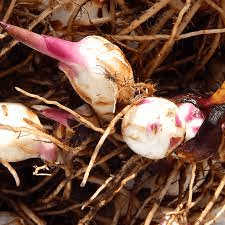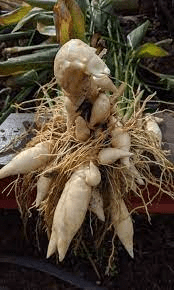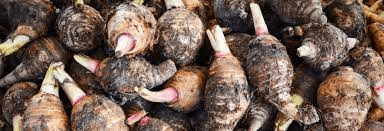Arrowroot tubers are the edible underground storage organs of the arrowroot plant, scientifically known as Maranta arundinacea. These tubers are thick, fleshy structures that grow horizontally beneath the soil surface and serve as a reservoir of nutrients for the plant.
Arrowroot tubers are a valuable source of starch and are used in various culinary and industrial applications.
Maranta arundinacea, commonly referred to as arrowroot, is a tropical perennial herbaceous plant native to South America. It produces clusters of thick, cylindrical tubers that can range in size from a few centimeters to several inches in length. These tubers are typically harvested when the plant reaches maturity, usually after one to two years of growth.
Arrowroot tubers are prized for their high starch content and neutral flavor profile. Once harvested, the tubers are washed, peeled, and grated to extract the starch. This starch is then processed into arrowroot flour, a fine, white powder with excellent thickening properties.
Arrowroot flour is commonly used as a gluten-free alternative to wheat flour in baking and cooking, where it imparts a smooth texture and glossy appearance to sauces, soups, and desserts.
In addition to their culinary uses, arrowroot tubers have been traditionally used for their medicinal properties. They are believed to have digestive benefits and are often consumed as a dietary supplement to soothe digestive discomfort and alleviate symptoms of diarrhea and indigestion.
Arrowroot tubers are also valued for their role in sustainable agriculture. As a perennial crop, arrowroot requires minimal inputs such as water, fertilizer, and pesticides, making it a viable option for environmentally friendly farming practices. Additionally, the cultivation of arrowroot can contribute to soil conservation and biodiversity preservation in tropical regions.
Arrowroot tubers are versatile and nutritious components of the arrowroot plant. Whether used for culinary, medicinal, or agricultural purposes, these starchy tubers play a significant role in various aspects of human life and contribute to the economic and ecological sustainability of tropical farming systems.
The Economic Importance and Uses of Arrowroot Tubers

1. Culinary Applications: Arrowroot tubers are widely used in culinary preparations as a source of starch and as a thickening agent. The starch extracted from arrowroot tubers is gluten-free and is often used in gluten-free baking and cooking to add texture and consistency to dishes.
2. Food Industry: Arrowroot tubers play a significant role in the food industry as a key ingredient in various products. Arrowroot starch, derived from the tubers, is used in the production of snacks, baked goods, sauces, and desserts, contributing to the texture and flavor of these food items.
3. Traditional Medicine: In traditional medicine systems, arrowroot tubers are believed to have medicinal properties and are used to treat various ailments. They are often consumed as a dietary supplement or brewed into a tea to aid digestion, relieve gastrointestinal discomfort, and boost overall health.
4. Herbal Remedies: Arrowroot tubers are utilized in herbal remedies and natural health products for their purported therapeutic effects. Extracts derived from arrowroot tubers may possess anti-inflammatory, antimicrobial, and antioxidant properties, which are beneficial for supporting immune function and promoting wellness.
5. Cosmetic Formulations: Arrowroot tubers are incorporated into cosmetic formulations for their absorbent properties and skin-friendly nature. Arrowroot powder, obtained from the tubers, is used in talc-free body powders, dry shampoos, and facial masks to absorb excess oil, soothe irritation, and promote a matte complexion.
6. Baby Care Products: Arrowroot tubers are a common ingredient in natural baby care products, particularly baby powders. The fine powder derived from the tubers is gentle on delicate skin and helps absorb moisture, preventing diaper rash and discomfort in infants.
7. Textile Sizing: Arrowroot starch, obtained from the tubers, is used as a natural sizing agent in the textile industry to improve the strength, smoothness, and crease resistance of fabrics during manufacturing.
8. Papermaking: Arrowroot starch is employed in the papermaking process as an additive to enhance paper quality and performance. It improves the strength, opacity, and printability of paper, resulting in high-quality print results.
9. Industrial Applications: Arrowroot tubers find applications in various industrial processes, including the production of adhesives, glues, and coatings. The starch extracted from the tubers serves as a natural and eco-friendly alternative to synthetic additives in industrial formulations.
10. Agricultural Practices: Arrowroot tubers contribute to sustainable agricultural practices by providing farmers with an alternative crop that is well-suited to tropical climates. Arrowroot cultivation helps diversify agricultural production, improve soil health, and support ecosystem resilience.
11. Livelihoods and Rural Development: Arrowroot cultivation provides livelihood opportunities for smallholder farmers and rural communities in tropical regions. The cultivation, processing, and marketing of arrowroot tubers generate income and employment opportunities, contributing to poverty reduction and economic development in rural areas.
12. Export Industry: Arrowroot tubers contribute to the export industry in countries where arrowroot cultivation is prevalent. Arrowroot products, including arrowroot starch, flour, and extracts, are exported to international markets for use in food, pharmaceutical, cosmetic, and industrial applications.
13. Soil Remediation: Arrowroot tubers play a role in soil remediation and environmental conservation by promoting soil health and fertility. The cultivation of arrowroot plants helps rehabilitate degraded soils, reduce erosion, and enhance nutrient cycling in agricultural landscapes.
14. Botanical Research: Arrowroot tubers are of interest to botanists and researchers studying plant morphology and development. Studying the growth and anatomy of arrowroot tubers provides insights into tuber formation, nutrient storage, and adaptation to environmental conditions.
15. Culinary Innovation: Arrowroot tubers inspire culinary innovation and creativity, particularly in gluten-free cooking and baking. Chefs and home cooks experiment with arrowroot flour and starch to develop new recipes and techniques that cater to individuals with dietary restrictions or food sensitivities.
16. Sustainable Agriculture: Arrowroot cultivation promotes sustainable agriculture practices by providing farmers with a low-input crop option that requires minimal water and fertilizer inputs. Arrowroot tubers are perennial and resilient to pests and diseases, making them suitable for agroforestry, intercropping, and diversified farming systems.
17. Food Security: Arrowroot tubers contribute to food security by providing a reliable and nutritious source of starch and carbohydrates in regions where staple food crops may be limited or unavailable. Arrowroot cultivation diversifies local food systems, enhances resilience to climate change, and supports livelihoods for smallholder farmers and rural communities.
18. Traditional Crafts: Arrowroot tubers are utilized in traditional crafts and cultural practices in some regions. The tubers may be used to create ornamental decorations, handicrafts, or ceremonial objects that hold cultural significance and artistic value.
19. Nutritional Supplements: Arrowroot extracts and derivatives are used in the formulation of nutritional supplements and dietary products aimed at promoting health and wellness. These supplements may contain bioactive compounds found in arrowroot tubers, such as vitamins, minerals, and antioxidants, which support immune function, digestion, and overall vitality.
20. Agroecological Restoration: Arrowroot tubers contribute to agroecological restoration efforts by improving soil fertility, biodiversity, and ecosystem services in degraded or marginal lands. The cultivation of arrowroot plants helps rehabilitate disturbed soils, restore vegetation cover, and create habitat corridors for native flora and fauna.
Read Also: The Curry Leaves: Economic Importance, Uses, and By-Products
The Products and By-products That Can Be Derived From Arrowroot Tubers

1. Arrowroot Starch: Arrowroot tubers are processed to extract arrowroot starch, a fine white powder used as a thickening agent in culinary and industrial applications. The starch is obtained by washing, peeling, and grinding the tubers to separate the starch granules from the fibrous matrix. Arrowroot starch is gluten-free, easily digestible, and suitable for individuals with dietary restrictions or sensitivities.
2. Arrowroot Flour: Arrowroot flour is another product derived from arrowroot tubers, obtained by drying and milling the tubers into a fine powder. Arrowroot flour is used in gluten-free baking and cooking to add texture and structure to recipes without the use of wheat flour or other gluten-containing grains. It is prized for its neutral flavor, smooth texture, and ability to produce light and airy baked goods.
3. Arrowroot Powder: Arrowroot powder, also known as arrowroot flour or arrowroot starch, is the dried and ground form of arrowroot tubers. It is used in various applications, including culinary, cosmetic, and medicinal formulations. Arrowroot powder has absorbent properties and a silky texture, making it suitable for use in body powders, dry shampoos, and talc-free cosmetics.
4. Arrowroot Extracts: Extracts derived from arrowroot tubers contain bioactive compounds with potential medicinal properties, including anti-inflammatory, antioxidant, and antimicrobial effects. These extracts are used in herbal supplements, dietary products, and natural remedies aimed at promoting health and wellness. Arrowroot extracts may support digestive health, immune function, and skin health when incorporated into dietary supplements or topical treatments.
5. Animal Feed: By-products of arrowroot tubers, such as spent tubers and leftover plant material, can be utilized as nutritious additions to animal feed formulations. These by-products contain valuable nutrients that support the health and growth of livestock, poultry, and pets, contributing to animal nutrition and welfare.
6. Soil Amendment: Arrowroot tubers can be composted and recycled as organic soil amendments to improve soil fertility, structure, and health. These by-products contribute organic matter, essential nutrients, and beneficial microorganisms to the soil, enhancing its ability to support plant growth and productivity.
7. Textile Sizing: Arrowroot starch, extracted from the tubers, is used as a natural sizing agent in the textile industry to improve the strength, smoothness, and crease resistance of fabrics during manufacturing. It helps stabilize fibers and enhance fabric performance, resulting in high-quality textile products.
8. Papermaking: Arrowroot starch is employed in the papermaking process as an additive to enhance paper quality and performance. It improves the strength, opacity, and printability of paper, resulting in sharper and more vibrant print results.
9. Industrial Applications: Arrowroot tubers find applications in various industrial processes, including the production of adhesives, glues, and coatings. The starch extracted from the tubers serves as a natural and eco-friendly alternative to synthetic additives in industrial formulations, contributing to sustainable manufacturing practices.
10. Botanical Research: Arrowroot tubers are of interest to botanists and researchers studying plant morphology and development. Studying the growth and anatomy of arrowroot tubers provides insights into tuber formation, nutrient storage, and adaptation to environmental conditions, informing agricultural practices and crop improvement strategies.
11. Culinary Innovation: Arrowroot tubers inspire culinary innovation and creativity, particularly in gluten-free cooking and baking. Chefs and home cooks experiment with arrowroot flour and starch to develop new recipes and techniques that cater to individuals with dietary restrictions or food sensitivities, expanding culinary possibilities and market opportunities.
12. Sustainable Agriculture: Arrowroot cultivation promotes sustainable agriculture practices by providing farmers with a low-input crop option that requires minimal water and fertilizer inputs. Arrowroot tubers are perennial and resilient to pests and diseases, making them suitable for agroforestry, intercropping, and diversified farming systems.
13. Agroecological Restoration: Arrowroot tubers contribute to agroecological restoration efforts by improving soil fertility, biodiversity, and ecosystem services in degraded or marginal lands. The cultivation of arrowroot plants helps rehabilitate disturbed soils, reduce erosion, and enhance nutrient cycling in agricultural landscapes, supporting landscape resilience and sustainability.
Read Also: 7 Medicinal Health Benefits Of Ribes divaricatum (Straggly Gooseberry)
Frequently Asked Questions (FAQ’s) About Arrowroot Tubers

1. What Are Arrowroot Tubers?
Arrowroot tubers are the underground storage organs of arrowroot plants (Maranta arundinacea), containing starch reserves used for plant growth and reproduction. They are elongated, cylindrical structures with a white to cream-colored flesh.
2. How Are Arrowroot Tubers Used in Cooking?
Arrowroot tubers are processed to extract arrowroot starch, a gluten-free thickening agent used in culinary applications such as sauces, gravies, soups, and desserts. Arrowroot starch is prized for its neutral flavor, smooth texture, and ability to produce glossy and translucent sauces.
3. Are Arrowroot Tubers Nutritious?
Arrowroot tubers are low in calories and fat but contain moderate amounts of carbohydrates, fiber, and essential nutrients such as potassium, phosphorus, and vitamin B6. They are a good source of resistant starch, which acts as a prebiotic and promotes digestive health.
4. How Do You Store Arrowroot Tubers?
Arrowroot tubers should be stored in a cool, dry place away from direct sunlight to prevent sprouting and spoilage. They can be kept in a well-ventilated pantry or stored in a perforated plastic bag in the refrigerator for extended shelf life.
5. Can Arrowroot Tubers Be Eaten Raw?
Arrowroot tubers are typically consumed cooked rather than raw due to their high starch content and mild flavor. They can be boiled, steamed, roasted, or fried to make a variety of dishes, including fries, chips, and casseroles.
6. Are Arrowroot Tubers Gluten-Free?
Yes, arrowroot tubers are naturally gluten-free and are suitable for individuals with gluten intolerance or celiac disease. Arrowroot starch, derived from the tubers, is a common ingredient in gluten-free baking and cooking.
7. Are Arrowroot Tubers Easy to Grow?
Arrowroot plants are relatively easy to grow in tropical and subtropical climates with well-drained, fertile soil and adequate moisture. They can be propagated from tubers or rhizomes and require regular watering and fertilization to thrive.
8. Can Arrowroot Tubers Be Used for Medicinal Purposes?
Arrowroot tubers are used in traditional medicine systems for their purported medicinal properties and therapeutic effects. They are believed to have soothing effects on the digestive system and may be consumed to alleviate symptoms of gastrointestinal issues such as indigestion and diarrhea.
9. How Do You Prepare Arrowroot Tubers for Cooking?
Arrowroot tubers should be washed, peeled, and trimmed before cooking to remove any dirt or debris. They can be sliced, diced, or grated depending on the recipe and cooking method.
10. Are Arrowroot Tubers Environmentally Sustainable?
Arrowroot cultivation is considered environmentally sustainable due to its low-input requirements and minimal environmental impact. Arrowroot plants are perennial and resilient to pests and diseases, reducing the need for chemical inputs and promoting biodiversity in agroecosystems.
11. Can Arrowroot Tubers Be Grown at Home?
Yes, arrowroot tubers can be grown at home in containers or garden beds in warm, humid climates. They require well-drained soil, regular watering, and partial shade to full sun exposure for optimal growth and tuber development.
12. What Are Some Culinary Uses of Arrowroot Tubers?
Arrowroot tubers can be used in a variety of culinary preparations, including stir-fries, stews, curries, and baked goods. They add texture and flavor to dishes and can be substituted for other starchy vegetables such as potatoes or tapioca.
13. Are Arrowroot Tubers Suitable for Diabetics?
Arrowroot tubers have a low glycemic index and are considered suitable for individuals with diabetes when consumed in moderation as part of a balanced diet. Arrowroot starch may help stabilize blood sugar levels and promote satiety due to its resistant starch content.
Read Also: Practical Steps to Convert Asphalt Wastes into Aggregate for New Construction

